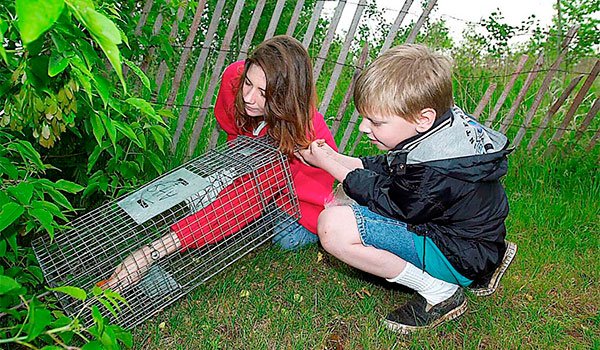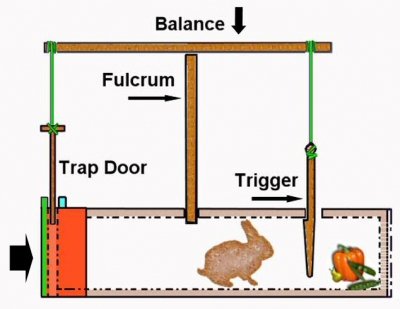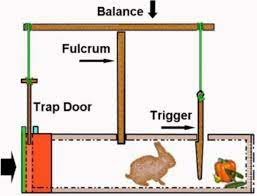How Make Rabbit Traps ?
When it comes to cheap and easy pest control, rabbit trapping is one of the greats. Any land owner with a wild rabbit problem can benefit from placing a simple trap or two on their ground. And there’s the joy, simple. It doesn’t take an expert to set, use or empty any kind of trap.
If used properly, these traps can supply a steady stream of rabbit meat for any ‘man of the land’. Making it ideal for people who want to eat fresh wild rabbit but have no time for hunting. Also a great joy to small gardeners, as traps allow for a minimum level of input but can really eliminate small rabbit problems.
But this doesn’t mean that traps can’t be used for larger land and rabbit problems. Different traps can yield much higher results such as pits (See more in “The Different Types of Traps” below), meaning that farmers can use this method in combination with others to receive greater results.
There are a few different types of traps, methods and baits you can use. Some people use a range of traps combined with other control methods but some use a cage or two to bulk their larders. What ever your aim, it can be easily achieved with the know-how.
Rabbit Trap Types
Which is Best for You?
With such a verity of rabbit trap types, which do you choose? Rabbit pest control is a fickle thing and it all depends on the situation. But choosing the correct type of traps, cages or pits can really aid rabbit control, on a big or small scale. Below is a range of different rabbit trap types split into categories:
Spring Based Traps
Triggered by weight, the traps spring will shorten and case the door to shut. The trapped animal will be safety enclosed in a cage or box ready to be dispatched. The advantage of this kind of trap is that it will be very easy to set (and reset) and has a high success rate. The downside is of course the price, as making a spring trap by hand is very difficult you will have to spend anywhere from £5 to £60 on a single trap.
I would suggest this trap to someone who is unwilling to put a lot of time into managing traps. A small amount of rabbit pest control is achieved with these spring traps unless used in mass, but they are great when used with other control methods.
Manually Triggered Traps
Also know as “old fashioned” rabbit traps, manually triggered traps are closed by the rabbit’s movements. This could mean anything from pulling on a string that cases the door to shut or forcing a sea-saw plank over its head, closing the way out. These traps are normally homemade and can be extremely cheap to make. The down side is that your chances of catching whatever walks in are entirely dependant on the quality of the trap, not forgetting the time it takes to make them.
This is an ideal method for gardeners with a DIY hobby, but not so great for farmers with little time to spare.
Pit Traps

Most pits have a ‘tunnel’ which leads the prey onto a spring loaded trap. Once a certain weight stands on top of the spring panel it will drop the rabbit into an enclosure. The joy of this trap is that its reset its self. The main downfall of using pits is that it needs to be buried in the ground and in the correct place (normally under a fence to look like an easy path in and out).
With the possibility to catch a massive amount of rabbits with very little need to check more then once a day, pits can be a massive aid to farmers or large land owners. Just make sure you do your research and are willing to pay!
Warning:
Many traps are illegal. Traps that cause harm such as the gin trap have been restricted and should no longer be used, ever. A general rule of thumb, if it causes blood, do not use it!
Which Rabbit Bait is Best for Trapping?
Using rabbit bait is a funny thing. It seems like the one thing you want a bunny to eat will be left well alone! Well have no fear, with a little bit of knowhow it’s easy to offer a meal that any bunny will be unable to turn their nose up at. Using good bait can easily double the catches from a cage trap!First things first, make sure the cage is in an area where the rabbits go (normally around the holes or near food) but make sure that the trap isn’t in the middle of ‘better’ food. Your rabbit bait has to stand out, putting some lettuce leafs under a overloaded apple tree wont tempt anything! And make sure the bait is at the back of the cage, the frustration of seeing a empty cage is almost unmatched…
‘Must Try’ Baits
Even An old apple core can make perfect rabbit baitBefore you consider going mad with unusual baits, try all of the basic rabbit baits first. Old fruit and veg from around your house are perfect. Potato peelings, apple cores, ‘slightly off’ bananas and all the other fruit and veg you would other wise throw away are more then good enough for your pests taste buds! Why let them go to waste?If you find no success, its time to upgrade to fresher fruit and veg. Lettuce leafs, raw cabbage and any salad thats green and leafy should do the job. You can also stick to tradition and go for carrots, dandelions and leafy weeds. I wouldn’t suggest using rabbit ‘snacks’ that you can buy from pet shops, they have never proven successful and cost a bomb!If none of the above work, you could always try…
“Unusual” Baits
When you talk about trapping baits, even one seems to have a magical kind of bait. I wouldn’t normally believe these stories, but a few can prove affective when the usual methods fail. I was once ferreting for a turkey farmer and he swore blind that turkey feed trapped no need of the pests. At first I didn’t believe him but after some research others claim that bird seed can be really affective.Another claim is that ‘cheesy’ biscuits work. Simply crumble them up. I have also heard that peanut butter works a treat, not forgetting jam. The list is endless, but my advice is to stick to the logical baits.
Other Tips and Tricks
Spraying your rabbit trap with cider can
really cover your smellRabbits have a strong sense of smell. When you put down the trap you can pass on a strong odor that warns the possible victim that something amiss. The best way to cover this is to spray (or drip) apple cider onto the trap.Don’t forget that trapping in the winter is much easier then in the summer. Food is far less available during the harsh cold months and makes your rabbit bait far more appealing.
Trapping Rabbit – Tips and Advice on Trap Placement
One of the best control methods available to any land owner (large or small), trapping rabbit remains the easiest way to protect your land. But it’s also great for hunters or for a lover of wild food. But yet, people are still confused about how to bait and where to place their traps. This page is all about where and how to place your cage and box traps to give you the best chance.
How to Handle Your Traps
You stink, it’s sad but it’s true. You smell so much rabbits can sniff your unnatural smells days after you put the trap down. So ether you stop using soap, or you cover your scent when placing your rabbit traps. First of all, leave the cage/box outside for a couple of days to let it air out.
Then when it comes to setting the trap, don’t cover yourself in deodorant, soap and the like. Most hunters or farmers have ‘hunting clothing’ or ‘work clothing’ that they don’t wash and that stink to high heaven. If you don’t have any unclean clothing, just make sure your not wearing anything that you have washed lately.
The next important bit of kit for trapping rabbits is a pair of gloves. Gardening gloves will do the trick but used leather gloves are the best bet. Yet again, leave these outside to let them air off and smell wild. These are the most important thing, so don’t skip this!
If you dress right, you should have no problem. But some people like to spray their trap with a sweet smelling cider. This will help bait the trap and cover your smell. The other option is to smoke the trap. You can do this with a lit torch or just by burning some newspaper inside the trap. If you ask me, it’s so easy its worth it.
Where to Place Your Rabbit Trap
One of the best tips for trapping rabbit I can give you is this; Rabbits follow food. Slapping the trap outside their holes and crossing your fingers will work, but it has half the affect of placing the trap where they graze.
Like in the photo above, the rabbits will often graze just outside of hedgerows. If you just place your rabbit trap facing the hedgerow here you won’t go far wrong. Just wait for rabbits to show and graze (or look for signs of them grazing) and take note. This is pretty much the best advice I can give for trapping rabbit!
But you do of course need to consider other things. If the trap is made of metal (or has metal on it), it will shine in the sunlight. This will make it seem less appealing to your prey but more worryingly, they can look very appealing to other hunters. I hate to think how many traps iv lost over the years. So learn from my mistakes. If you think they might ‘go walkies’, place them out of sight.
Other Tips for Trapping Rabbits
• Place the trap so its entrance is facing the holes or hedgerow.• Nothing in the trap? unless you plan to move it, don’t touch it. The rabbits might begin to ‘trust’ the trap more over time.• Check your traps regularly, its cruel to leave a live rabbit inside of a trap for anything longer then a day.• It is illegal to move rabbits off your land. If you catch one, you have to kill it or let it free into your land again. Would you want people letting rabbits loose on your land?• Although trapping rabbits is great for pest control, it can only catch so many. If you have a large problem you might have to use other methods as well as trapping to see any affect.
How to Remove Rabbits from Rabbit Traps
Although it might sound easy, rabbit traps make removing a rabbit from them a bit of a challenge. When I first starting using traps I fell for the old error of thinking “Easy job” and ended up losing my very first catch. Its truly gutting and something you want to avoid!
There are a few things that could go wrong. The first being that the animal will bolt out of the trap the first chance you give it. The second is that it kicks you and leaves a nasty scratch, which almost hurts as much as loosing one! But lets clear one thing up once and for all…
You Can Not Release the Rabbit Elsewhere!
A common misconception is that taking the pest out of the rabbit trap and moving it else where solves anything. If you do this, the chances are the rabbit will simply die because of the confusing change,the new environment or just the fact it doesn’t know the place you moved it to. Not forgetting the fact that who ever the land belongs to properly is trying all the hunting methods he knows to kill the things!
In the UK it is breaking the law just to ‘re-home’ the rabbit, its also immoral because your giving the problem to someone else and your likely causing the rabbit more suffering then killing it yourself. So in short, if you don’t have the heart (or know someone that does) to kill your pray, don’t hunt it. You could always try using rabbit repellents .
So You have the Rabbit Trapped, Now What?
Got one? Great! Shows that your using your rabbit trap properly. But now it comes to removing the rabbit and its far from a simple job. Its important you know which part of the rabbit is likely to cause the most damage. Firstly, a rabbit will never bite you. I must have had over one thousand wild rabbits in my hands and they have never ever tried. The only part you really have to worry about is their back legs.
Generations of digging has giving the burrowing pest one hell of a set of legs. Match that with its claws and you could feel some pain. The next thing you need to do is make sure there’s no chance for the animal to run away. The problem with rabbit traps is you have to open it to get the rabbit out.
Now there are two ways of solving this. Some people like to shot the rabbit while its still in the trap. This works but isn’t something I would ever recommend as the shot can easily hit the cage and bounce back at you. Best case you break your rabbit traps, worst case you end up in A&E;, so think twice before doing this.
The best way to remove the bunny is by tilting the trap backwards. This will mean the rabbit falls into the back of the trap and the entrance is facing upwards. In other words, the only way out is to jump from the back to the front at 90 degrees. Since I started doing this I haven’t lost a single catch and its just about the only way to do it.
Where and How to Grab
Once you have tilted the rabbit traps up you still need to get hold of the rabbit in a way that means you can kill it without it kicking you and getting away anyway. The best place to hold them is by the back legs. If you can, get the back legs in one hand and the middle of its body in the other. This will give it very little wiggle room.
Still worried about being scratched? It happens no matter how well you handle it. Some people like to wear thick gardening gloves and it works a treat as these will also keep your scent off of the traps.
Below is our our old article
Make Rabbit Traps
Rabbits have invaded my garden, and it doesn’t take them long to do some serious damage!
“OOOHHH – I’m going to get those wascally wabbits!”

Rabbit season here in Kentucky is November through February. So to make sure I stay on the right side of the law, I’ve been experimenting with making Live
Catch rabbit traps for use outside of the rabbit season. I’ve been enjoying making rabbit traps and catching rabbits as much as I enjoy gardening.
This lens focuses on How to Make Rabbit Traps.
I have some great designs to share, so check back often for updates.
Video on Making Your Rabbit Trap
Here is a great YouTube video on how to make your rabbit trap from scrap wood that you probably have around your home. This rabbit trap uses a false floor and is approximately 30 inches long. One 12 foot long 1″ x 8″ board, a coat hanger, and some screws are all you need to make this trap. This guy doesn’t go into a lot of details on how to make the trap, but he shows you enough to where you can easily make one yourself. Good luck with it and leave a comment if you make one and have some success with it.
Live Catch Rabbit Traps
If you have a rabbit problem and don’t have time to make your rabbit traps, then check out some of these live-catch rabbit traps from Havahart. Havahart is one of the most famous makers of no-kill animal traps. They make some different models and sizes and are reasonably priced. You can use these live-catch traps to relocate those pesky rabbits from your garden, without being concerned about breaking any of the Fish and Game laws.
Homemade Rabbit Trap
Homemade Rabbit Traps in less than an hour

I read an article on Backwoods Home Magazine that explained how to make a simple Live Catch rabbit trap in less than an hour.
These same instructions can be adapted for live catch raccoon, opossum, squirrels, and skunks.
Click the following us for more outdoor tips .










